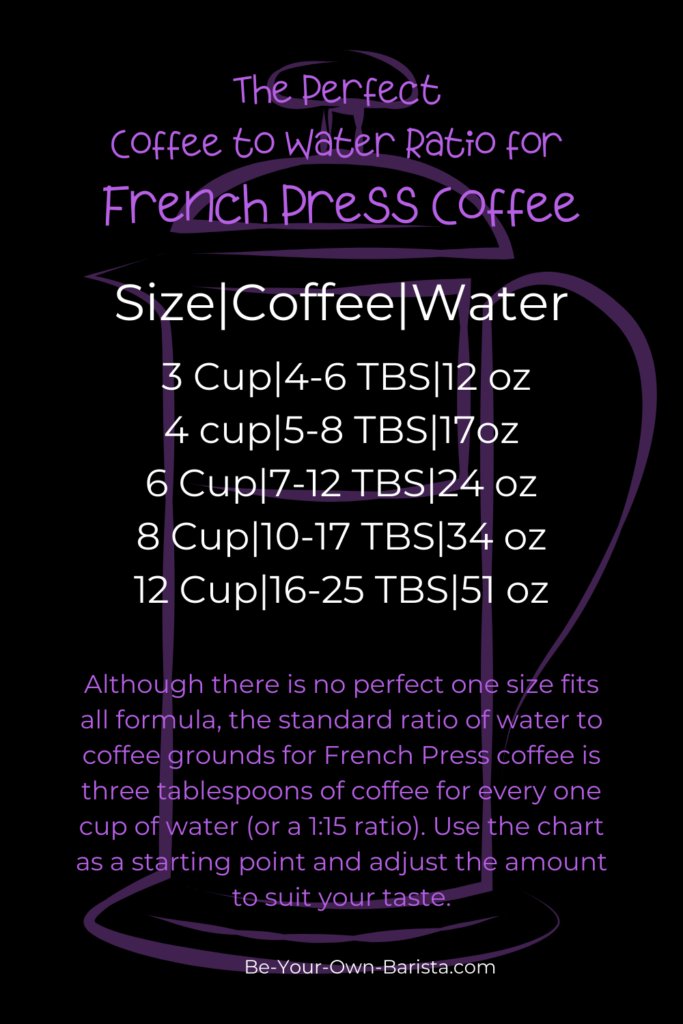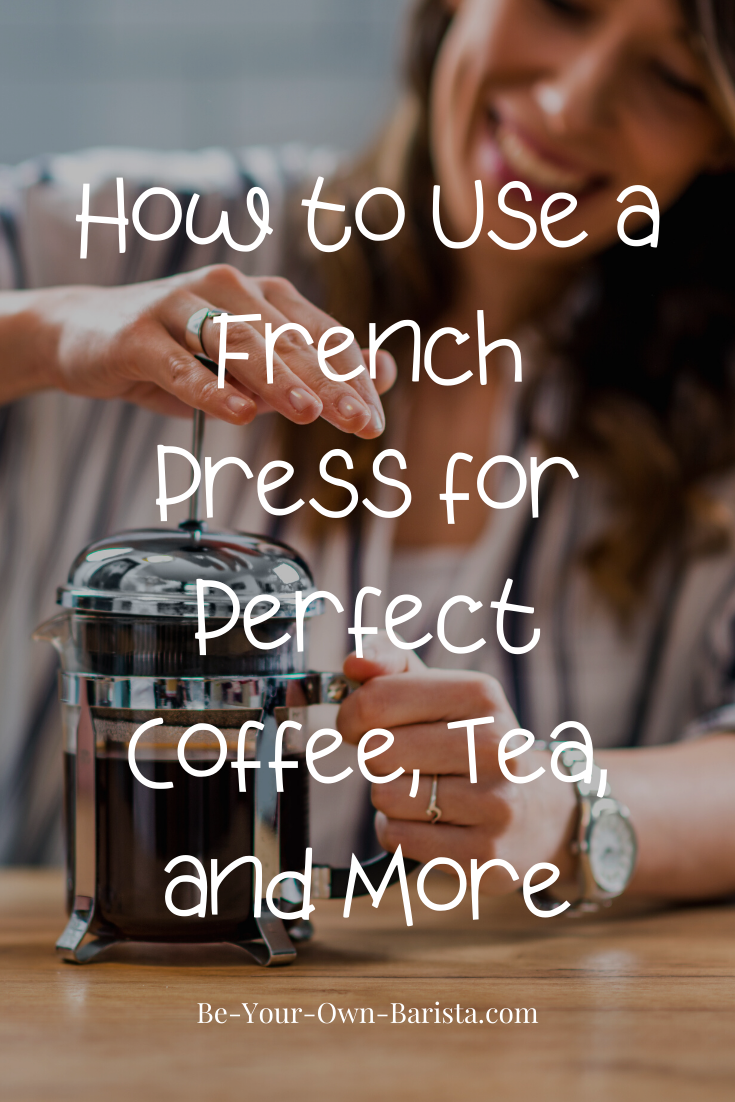The French Press is more than just a simple and elegant way to brew the perfect cup of coffee or tea. It’s an essential tool for any home barista! Here’s how to use a French Press for coffee, tea, and more.
In the age of app-controlled, single-pod coffee brewing at the touch of a button, there’s something elegant and simple about brewing coffee in a French Press that really appeals to me. Although it’s not hard to make perfect coffee in a French press, learning how a French Press works does require some careful measuring to get the ratio of coffee to water just right. Timing is also crucial to getting the perfect cup of French Press coffee.
While the French Press is well loved for making amazing coffee, it can also be used to make the perfect cup of loose-leaf or chai tea. In fact, a French Press is also a fantastic and simple way to froth warmed milk for cappuccino and other fancy coffee drinks if you don’t have an espresso machine.
Love hot chocolate? Once you experience the luxurious creaminess of hot chocolate made in a French Press, you’ll never do it any other way! It’s also a great way to make a Caffe Mocha without an espresso machine.
And, there’s more! You can also use your French Press to make concentrated coffee to replace the espresso in your favorite recipes if you don’t have an espresso machine. Or, use it to make decadent whipped cream to top off your creations. I also have a separate tutorial on using the French Press to make cold brew coffee.
This is truly an essential tool that belongs in every home barista’s kitchen. Here’s how to use a French Press to make the perfect cup of coffee or tea, and so much more!
 |
Maui Moka – $9.95
from Hawaii Coffee Company Maui Moka comes from coffee trees first commercialized almost 1,000 years ago in Yemen. This exotic Moka varietal, from the original Aribia Felix (grown in the birthplace of all coffee) is now grown in limited quantities high above the white sand beaches, on the gentle slopes of the West Maui Mountains. Moka’s tiny beans, often mistaken for peaberry due to their small size, have long fascinated coffee aficionados. Coffee experts are predicting that the unique flavor of the Moka bean has the potential to establish the Maui area as a recognized specialty coffee region, similar to Kona. This coffee has very moderate acidity, with an Afro-Arabian fruit and chocolate cup character. Brewed in a standard drip coffee maker, you’ll notice the chocolate & fruit taste most prominently. A French press brings out a deep smokey chocolate nose and flavor. Please note; this is not a flavored coffee. It is a descendant of the Yemen Mokka varietal and has an all-natural flavor reminiscent of chocolate and fruit that made Yemeni Coffees famous centuries ago, and still today. Limited Edition Coffee Roast Type: Medium Roast |
A Brief History of the French Press
Although two Frenchman patented a simplified version of the French Press back in 1852, the modern version was actually patented by an Italian. The first French Press as we know it today was patented in Italy back in 1929 by Attilio Calimani and Giulio Moneta.
It took several decades for the device to really catch on, and when it did, it was marketed under the name Chambord, which we still see today. Although the design has been modernized in a variety of ways, the basic concept and technique are still the same.
How a French Press Works
A French Press works by steeping the coffee grounds in hot water in a glass carafe (called a beaker). After the desired steeping time, a metal mesh filter is pushed to the bottom of the beaker using a plunger. The filter is designed to fit snugly into the beaker, so it separates the coffee grounds from the coffee, which is then ready to pour into your mug.
A French Press works using a process called immersion brewing, and it allows the natural oils found in coffee to pass through the filter. Because the coffee is steeped for a few minutes, rather than just passing over the coffee for a few seconds as in drip coffee, the flavors are extracted more evenly, and the coffee has a fuller flavor and a thicker body.
The timing, ratio of coffee to water, and size of the grind are all crucial to the process. If they’re not just right, you could easily end up with bitter, over-extracted coffee, coffee that’s full of sediment, or coffee that’s too weak.
 |
Grande Domaine Vienna Roast Ground Kona Coffee – $30.00
from Koa Coffee There is no other Kona Coffee like this one. It stands alone. Our Grande Domaine Kona has gained notoriety by being selected as a Kona Coffee Cupping Contest Winner for outstanding quality and balance. Sun-drenched Kona Coffee, handpicked and roasted to a glorious Vienna Roast to bring out all the flavor of these unique Kona Coffee beans. Pairing this coffee with your French Press will spoil you for any other. A cup of oh-my-gosh sent directly from Hawaii to your door, with Aloha! |
French Press Coffee to Water Ratio
The standard ratio of water to coffee grounds for French Press coffee is three tablespoons of coffee for every one cup of water (or a 1:15 ratio). However, you can adjust the ratio according to your preference.
We recommend starting with the standard ratio and then using the chart below to adjust the amount of coffee to suit your taste and the roast you’re using. The lower amount will result in a mild brew and the higher amount will result in a strong brew.
| Size of French Press | Amount of Ground Coffee | Amount of Hot Water |
| 3 Cup | 4 to 6 Tablespoons | 12-ounces/350ml |
| 4 Cup | 5 to 8 Tablespoons | 17-ounces/500ml |
| 6 Cup | 7 to 12 Tablespoons | 24-ounces/700ml |
| 8 Cup | 10 to 17 Tablespoons | 34-ounces/1000ml |
| 12 Cup | 16 to 25 Tablespoons | 51-ounces/1500ml |
They type of beans you are using, the roast, the grind size, and the timing all play a part in the strength and flavor of your final product. Every batch you brew can come out entirely different, so be prepared to do a little experimenting to find out exactly what you like.

Grinding the Beans for French Press Coffee
As with any other brewing method, always choose freshly roasted beans and grind them right before you brew your coffee. For French Press coffee, the grind should be medium-coarse. To give you an idea of what that should look like, you’re going for something like the texture of breadcrumbs.
If your grind is too fine, you will end up with a lot of sediment in your coffee. You also run the risk of having bitter, over-extracted coffee. If your grind is too coarse, the flavors won’t be extracted enough, and your coffee will be too weak.
And finally, always use a burr coffee grinder to grind your beans. A burr grinder will give you the most uniform grind size, ensuring that your coffee extracts evenly and giving you the best tasting final product.
How do you use a French Press to make coffee?
What you need:
- French Press
- Filtered Water and a Way to Heat It
- High-Quality, Freshly Roasted Coffee Beans
- Freshly Ground Coffee (Medium-Coarse Grind as Described Above)
- A Tablespoon
- A Timer or Clock
- Stirring Spoon with a Long Handle or a Chopstick
Here’s How to Brew Perfect French Press Coffee:
- Start by heating up the beaker and filter of your clean French Press. The easiest way to do this is to fill it with hot water, put on the lid, and move the plunger up and down a few times. I like to let the hot water sit in my French Press while I grind the coffee, and then pour it out when I’m ready to start brewing.
- Now, measure your coffee grounds according to the chart above and put them in the bottom of your empty French Press.
- Heat your water in a saucepan, stovetop kettle, electric kettle, or in the microwave. The perfect water temperature for French Press coffee is 205 degrees F. You can use a thermometer to check the temperature, but I simply bring my water to a boil, then take it off the heat and let it cool for about 30 seconds before measuring. Always measure your water according to the chart above after you heat it to accommodate for evaporation during the heating process.
- Pour just enough of your measured, heated water into your press to barely coffee the coffee grounds. Give it a stir and wait 30 seconds to allow the coffee grounds to bloom and release their oils.
- Go ahead and add the rest of the water and give it another gentle stir. Put the lid on your press to keep everything nice and hot, but don’t push the plunger down just yet.
- Now, you’re ready to start timing. For most people, the ideal steep time for French Press coffee is 3 to 4 minutes. Shorter for a mild brew, longer for a strong one. Feel free to experiment and adjust the timing to suit your tastes.
- When the time is up, slowly and evenly press the plunger all the way down to the bottom. There should be some resistance, but not so much that you can’t push it down steadily. If there’s too much resistance, you may have ground the beans too fine. If there’s no resistance, the grind may be too coarse.
- Pour your coffee into a mug and enjoy. Always decant any extra coffee into a thermal carafe right away. Do not leave it sitting in your French Press because it will continue to pull flavor from the grinds, resulting in bitter, over-extracted coffee.
How to Froth Milk in a French Press
The process really couldn’t be easier! To froth milk in a French Press, start by heating it to just below simmering on your stovetop or in the microwave. Pour it into a clean, pre-heated press and plunge the plunger up and down until the milk doubles in volume. You can use any type of milk or milk alternative, but results will vary. Regular, whole milk produces the best foam.
Making Concentrated Coffee for Your Favorite Espresso Drinks
Of course, you can’t make true espresso without an espresso machine. But, in a pinch, you can make a pretty decent substitute with your French Press. Follow the same technique outlined above. A dark espresso roast coffee bean will give you the most authentic espresso flavor.
Most espresso drink recipes call for a double shot of espresso, which amounts to about ¼ cup. To make a similar amount of concentrated coffee in your espresso machine, use 3 tablespoons of grounds for each ¼ cup of water to your press.
Making Hot Chocolate in a French Press
To make a cup of hot chocolate in a French Press, measure two tablespoons of your favorite cocoa powder into the bottom of your clean French Press. Add two tablespoons of sugar or the equivalent of an alternative sweetener. Pour 8-ounces of steaming hot milk into the French Press and plunge the plunger up and down until combined and foamy. You’ll end up with the richest, creamiest hot chocolate ever!
How to Use a French Press to Make Whipped Cream
It’s so easy to make whipped cream in a French Press! Pour one cup of chilled whipping cream into your press. Put on the lid and plunge the plunger up and down until the desired thickness is achieved. You will end up with about two cups of whipped cream that can be stored in the fridge for 3 to 5 days.
If you want sweeter whipped cream, add one or two teaspoons of powdered sugar to the cream before you start plunging. You can also add a teaspoon of your favorite extract, such as peppermint or vanilla, if you want a flavored whipped cream.
How do you use a French Press to make tea?
The process of making loose-leaf or chai tea in your French Press is much the same as making coffee. Of course, you’ll need to adjust the water temperature, steep time, and the amount of tea according to your taste and the type of tea you’re making.
- Water Temperature for Brewing Tea
According to loose-tea experts, water for chai, black tea, oolong tea, and herbal tea should be at a full boil. For green and white teas, use water that’s been off the boil for about 30 seconds.
-
Ideal Steeping Times for Tea
Check the instructions for your particular tea for optimal amounts and brew times. For most types of tea, you’ll need 1 teaspoon of tea for every 8-ounces of water. Ideal steep times are usually 3 to 5 minutes, with green tea and white requiring shorter times, oolongs, chai, and black teas somewhere in the middle.
Herbal teas require longer steeping times. You can adjust brew times according to your taste but be aware that tea can become bitter if over-extracted, much like coffee. Once ideal steep times are reached, pour your tea into a mug or carafe for the best flavor. Always rinse out your coffee maker right away so the tea leaves don’t stain it.
More Creative Ways to Use a French Press
Although I stick mainly to using my press to make beverages, it turns out that there are lots of uses for one around the kitchen! Try using it to rinse grains, infuse oils, rehydrate dried foods, or make fruit infused water. For such a compact and affordable gadget, the French Press is extremely versatile!
Final Thoughts
As you can see, the compact and affordable French Press is an essential tool for the home barista’s kitchen! It’s such a simple and elegant way to make the perfect cup of coffee or tea, but it can do so much more. Do you use your French Press in a creative way that we didn’t mention above? Please share it in the comments below so we can all take advantage of your genius!






